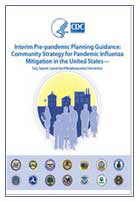| "We must be prepared to face the first wave of the next pandemic without vaccine and potentially without sufficient quantities of influenza antiviral medications." Interim Pre-pandemic Planning Guidance - CDC |
Background

A pandemic has to start before we can begin making a vaccine that will be certain to help. Antiviral medications such as Tamiflu may not work, or they may be in short supply. That means we will NOT have medical solutions in time.
The Centers for Disease Control and Prevention (CDC) has developed guidelines to limit the spread of a pandemic until a vaccine can be developed and produced. These guidelines, called Community Mitigation Guidance, are community-based protection strategies. These were developed by looking at what different cities did in the 1918 flu pandemic to slow the spread of flu.
Community Protective Measures
Individuals and groups in a community can help protect themselves AND their communities by doing certain things to slow the spread of the disease. Government officials, businesses, schools and individual citizens all will have important roles to play.
The following community protective measures are described in the CDC's Non-Pharmaceutical Interventions for Use During a Human Influenza Pandemic (Pre-Publication). They are called Non-Pharmaceutical Interventions (NPIs) because they do not use pharmaceuticals (drugs or vaccines). NPIs are the
most important primary protective mechanism for everyone in the community.
- Isolation and supportive treatment of all people suspected to have influenza. Isolation should usually occur in the home, but could be in a healthcare setting, depending on the severity of an individual's illness and/or the current capacity of local healthcare infrastructure.
- Voluntary home quarantine of members of households with confirmed or probable influenza case(s).

- Social distancing of children, for example school closure and/or suspension of all school-based activities and childcare programs (including public and private schools, as well as colleges and universities), combined with social distancing in the community to achieve reductions in out-of-school social contacts and community mixing.
*This is the most important measure, since this age group is very vulnerable to infection.
Social distancing means deliberately limiting contact with other people. This means- children stay at home
- no mall visits, no theaters, no playgrounds, no team sports
- no getting together with friends for visiting
 Use of social distancing measures to reduce contact among adults in the community and workplace. Measures will include canceling large public gatherings, altering workplace environments and schedules to decrease social density and to preserve a healthy workplace to the greatest extent possible, without disrupting essential services.
Use of social distancing measures to reduce contact among adults in the community and workplace. Measures will include canceling large public gatherings, altering workplace environments and schedules to decrease social density and to preserve a healthy workplace to the greatest extent possible, without disrupting essential services.
How Community Protective Measures Work
These strategies are all designed to slow the spread of pandemic flu by decreasing contact between sick and well people. This
reduces, but does not eliminate, your exposure to the pandemic flu virus. Slowing the spread of pandemic flu through the early use of multiple community-level protective measures may buy time, reduce illness and save lives. In addition, the demand for healthcare is reduced, and time is 'bought' to develop a vaccine. This is shown in the following graphic from the CDC:
Implementation

The community protective measures developed by the CDC are guidelines or suggestions. The implementation will be local, usually under the direction of public health officials.
These measures may be used alone or in combination. For severe pandemics all could be used for up to 12 weeks or for the duration of the pandemic locally. For less severe pandemics, a shorter period of implementation may be adequate to realize the health benefits.
| "… authorities should introduce interventions early in an emerging pandemic, rather than after a pandemic is well established; the effectiveness of NPIs (non pharmaceutical interventions) will decrease rapidly as more people become infected and ill from influenza." CDC/pandemicflu.gov |
These measures will save lives if used early and effectively. The timing is part of effective government. If they are used too late, the spread of infection will not be slowed appreciably. In that case, we will have all the economic and social hardship of using the measures, but none of the health benefits. The timing has to be just right, and that is where effective government will help.
What is timing that is 'just right?' "This [HHS/CDC] guidance suggests the primary activation trigger for initiating interventions be the arrival and transmission of pandemic virus. This trigger is best defined by a laboratory- confirmed cluster of infection with a novel influenza virus and evidence of community transmission (i.e., epidemiologically linked cases from more than one household)."
Interim Pre-pandemic Planning Guidance – CDC In plain language, what does this mean? The CDC is recommending using community protective measures when you have the first confirmed cases of human-to-human pandemic flu
in your State or neighboring state. This strategy will save lives. And it is worth it. But we must understand why it is being recommended, and we must be prepared for the difficulties such measures will bring.
Difficulties

"Communities must be prepared for the cascading second- and third-order consequences of the interventions, such as increased workplace absenteeism related to child-minding responsibilities if schools dismiss students and childcare programs close." Interim Pre-pandemic Planning Guidance - CDC.
Using the NPIs will be difficult for families and communities. The biggest problem will be what to do with all those children who are usually in school and daycare programs. If parents have to stay home to care for their children, this will cause hardships all around. The concerns include
- the economic impact to families
- the potential disruption to all employers, including businesses and governmental agencies
- access to essential goods and services
- the disruption of school-related services (e.g., school meal programs)

Other measures, such as home isolation and voluntary home quarantine of members of households with ill persons, would also contribute to increased absenteeism from work and affect both business operations and employees.
These are significant challenges that need to be worked NOW, from both a family and community perspective. Many businesses are exploring telecommuting as a workplace alternative. Communities need to find strategies to minimize the impact of interrupting school meal programs and other essential services.
What you can Do
- Begin by getting informed. Print and review Appendix 6 - Pandemic Influenza Community Mitigation Interim Planning Guide for Elementary and Secondary Schools in CDC's "Community Strategy for Pandemic Influenza Mitigation."
Augment this with current information at Wikipedia since the Fluwikie site is no longer available.
- Then get involved and help create your community's strategy to minimize the spread of pandemic influenza. The starting place is local pandemic plans. If they are written, read them. Suggest changes if needed. If they are being drafted, volunteer to help write them. Example organizations to work with are
- Protect your children when a pandemic begins. Remember – the earlier schools close, the greater the protection from infection for all children. If your schools/daycare centers do not close, you will want your children to be at home. See Staying Healthy - Good Practices on this website for additional suggestions.